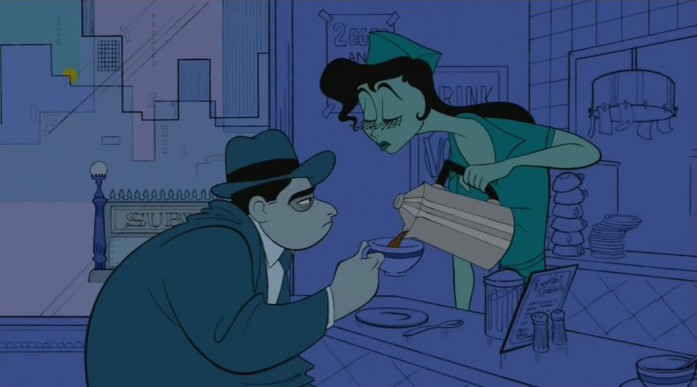Review: Fantasia 2000 (1999)
In recent years Walt Disney Animation Studios has seen a resurgence in its pop culture capital with the mega-success of Frozen and the critical and popular acclaim of films like Tangled and Big Hero 6 (their most recent Oscar success). Before Tangled (goes the narrative) Disney had been playing second fiddle to Pixar Entertainment, putting out disappointing, derivative fare like Chicken Little and Meet the Robinsons that couldn’t be distinguished from the lacklustre films of their competitor, Dreamworks Animation. This perspective might be true, but it overlooks the small films of Disney’s that have popped up over the years during so-called creative dry-spells. A prime example of the fascinating experimental work that Disney can conjure when they have nothing to lose is Fantasia 2000, a sequel to the classic 1940 Disney musical feature.
Like its predecessor, Fantasia 2000 features short animated sequences scored to famous pieces of classical music. The sequences (essentially separate short films) mean to capture the heart of the music they’re scored to, visualizing the music in a way listeners would never imagine. Fantasia 2000 never reaches the heights of sublime invention that the original Fantasia does, but it proves to be some of the most elegant and moving animation Disney has created in the past two decades.
The best of the film’s eight sequences is Rhapsody in Blue by George Gershwin. Familiar to filmgoers from its use in the opening moments of Woody Allen’s Manhattan, Rhapsody in Blue is, in many ways, the song of New York City. Not wanting to strip NYC from Gershwin’s music, as the two are intimately joined, segment director Eric Goldberg makes it a vignette about various sad individuals living in an ambiguously mid-century New York City. There’s the construction worker who longs to be a jazz drummer, the unemployed schlub who doesn’t have enough money to buy a donut at the local cafe, the little girl who yearns to have parents who adore her, and the husband who is merely a bank account for his extravagant wife. These characters interact and go about their quiet lives as Gershwin’s jazz-influenced piece dictates the emotional mood of the scenes. The art style is based off the newspaper caricatures of the New York Times cartoonist, Al Hirschfeld. As a result, the character animation is highly stylized. This two-dimensional graphic aspect combined with the blue colour palette makes Rhapsody in Blue a stylized callback to Disney’s postwar modernist period, and one of their best shorts of the past several decades.
It’s also not the only winner among the eight segments of Fantasia 2000. There’s a third act reprise of the famous The Sorcerer’s Apprentice segment from the original Fantasia. (Apparently Walt Disney originally envisioned Fantasia as an ever-evolving feature that would have new segments added to it over the years as well as retaining old favourites as it came and went from theatres. Too bad we’ve only gotten two Fantasias despite Walt’s desires.) There’s a short, clever sequence using Camille Saint-Saëns’s The Carnival of the Animals, Finale to depict a flamingo with a knack for playing yo-yo. Although the most common criticism of Fantasia when it originally premiered was that the blend of cartoonish humour and refined classical music was tasteless, there’s something wittily atypical about using high art to score low humour. As well, just as Mozart or Beethoven catered to the masses with their controversial (in their time) music, Disney uses a dwindling art form and makes it new and accessible for people who would never be exposed to it otherwise. Thus, the sight of a flamingo playing with a yo-yo is ludicrous, but also inventive and bizarrely appropriate when scored to Saint-Saëns.
The second segment set to Pines of Rome from Ottorino Respighi shows humpback whales gaining the ability to fly when a supernova strikes and one calf getting separated from its parents. The images of flying whales amidst icebergs and frozen caves is beautiful and another example of Disney expertly blending traditional animation with computer effects around the turn of the millenium. The last segment using Igor Stravinsky’s Firebird Suite — 1919 Version is a showstopping finale, following the death and rebirth of a mountainside. Its images of ecological disaster and nightmarish spirits recalls classical Disney works, specifically Bambi and the Fantasia segment, Night on Bald Mountain.
Even the lesser segments have their charms to them. One segment uses Dmitri Shostakovich’s Piano Concerto No. 2 in F Major, Allegro, Op. 102 and bases its story on “The Steadfast Tin Soldier” by Hans Christian Andersen. Another depicts geometrical shapes taking flight as butterflies set to Ludwig van Beethoven’s Symphony No. 5 in C Minor, I. Allegro con brio. The second last segment shows Donald and Daisy Duck as assistants to a biblical Noah during the Flood scored to Edward Elgar’s Pomp and Circumstance — Marches 1, 2, 3 and 4. None of these segments hit the heights of the Gershwin or Stravinsky moments, but they’re still bright and amusing in that patented Disney way.
Granted, there are weak aspects to Fantasia 2000 that are not present in the original. The celebrity introductions to each segment are unnecessary and intrusive, and the footage of the Chicago Symphony Orchestra conducted by James Levine never reaches the mysterious awe of the original orchestra segments with Leopold Stokowski. But the segments on a whole are a delight. They are an opportunity for animators to let their imaginations run wild and develop new techniques and styles of storytelling. Fantasia 2000 is one of those rare occurrences where Disney seems to be pursuing art devoid of economic motivations. It’s animation for the pure sake of invention.
8 out of 10
Fantasia 2000 (1999, USA)
Directed by Don Hahn, Pixote Hunt, Hendel Butoy, Eric Goldberg, James Algar, Francis Glebas, and Paul and Gaëtan Brizzi; story by Don Hahn, Irene Mecchi and David Reynolds, Eric Goldberg, Hans Christian Andersen, Joe Grant, Perce Pearce and Carl Fallberg, Elena Driskill, and Paul and Gaëtan Brizzi.
